Morocco is a land of rich and diverse culture. Its music and dance reflect its vibrant heritage. From Berber music’s lively beats to Gnawa’s soulful tunes, Moroccan music is unique and captivating. The dances, full of color and energy, tell stories of the past and present.
The music of Morocco has many forms. Each form comes from different regions and traditions. For example, Berber music is from the mountains, while Andalusian music originates in Spain. This mix of influences makes Moroccan music special. Instruments like the oud, darbuka, and qraqeb add to the distinct sounds.
Dancing in Morocco is just as varied. Each dance style has its history and meaning. Shikhat is a popular dance at celebrations. Sufi Dance, or Hadra, is more spiritual. These dances show the joy and spirit of the Moroccan people.
Understanding the music and dance of Morocco helps us appreciate its culture. It shows us the heart and soul of its people.
Traditional Music Styles
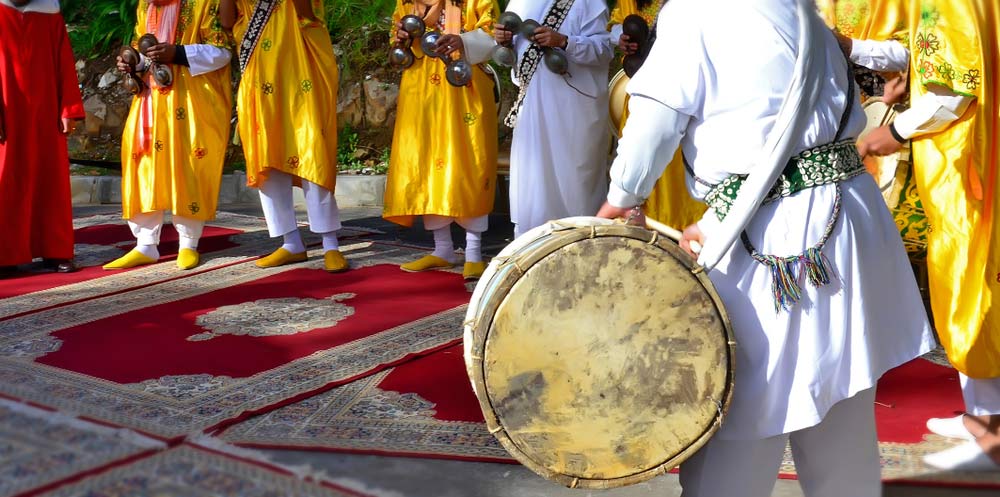
Berber Music
Berber music is deeply rooted in the traditions of the Berber people inhabiting the Atlas Mountains. This music is characterized by lively rhythms and strong beats, often accompanied by communal singing. Berber musicians use a variety of traditional instruments, such as drums, flutes, and the “imzad,” a type of one-stringed fiddle. Songs are typically about daily life, nature, and historical events. Festivals and community gatherings are common settings for Berber music performances, where the whole village comes together to celebrate and share their cultural heritage.
Rwais
Rwais is a distinct style of Berber music that originates from the Souss region in southern Morocco. The term “Rwais” refers to both the musicians and the music they perform. These traveling musicians play the “rebab,” a bowed string instrument, and often accompany their songs with poetry that reflects themes of love, heroism, and nature. The Rwais tradition dates back centuries and continues to be an important cultural expression. Performers typically dress in traditional costumes and use their music to preserve and pass down oral histories and cultural knowledge.
Al-Ala
Al-Ala, also known as Andalusian music, has its roots in medieval Spain and was brought to Morocco by Andalusian refugees. This genre is known for its sophisticated and refined sound. The music is structured into “noubas,” which are suites that follow specific melodic and rhythmic patterns. Instruments commonly used in Al-Ala include the oud (a lute-like string instrument), the qanun (a type of zither), and various types of percussion. The lyrics of Al-Ala songs often revolve around themes of love, nature, and devotion, and the performances are usually formal, often taking place in cultural festivals and special ceremonies.
Amazigh Music
Amazigh music, representing the Amazigh (Berber) people, varies significantly across different regions of Morocco. Each region has its own unique style and instruments. In the High Atlas, for example, the “ahwash” involves group dances and singing, while in the Middle Atlas, the “ahidous” features a more structured dance with poetic lyrics. Common instruments include the “lotar” (a stringed instrument similar to the guitar) and various types of drums. Amazigh music is vibrant and often performed during important community events like weddings, harvest festivals, and religious celebrations.
Instruments of Moroccan Music
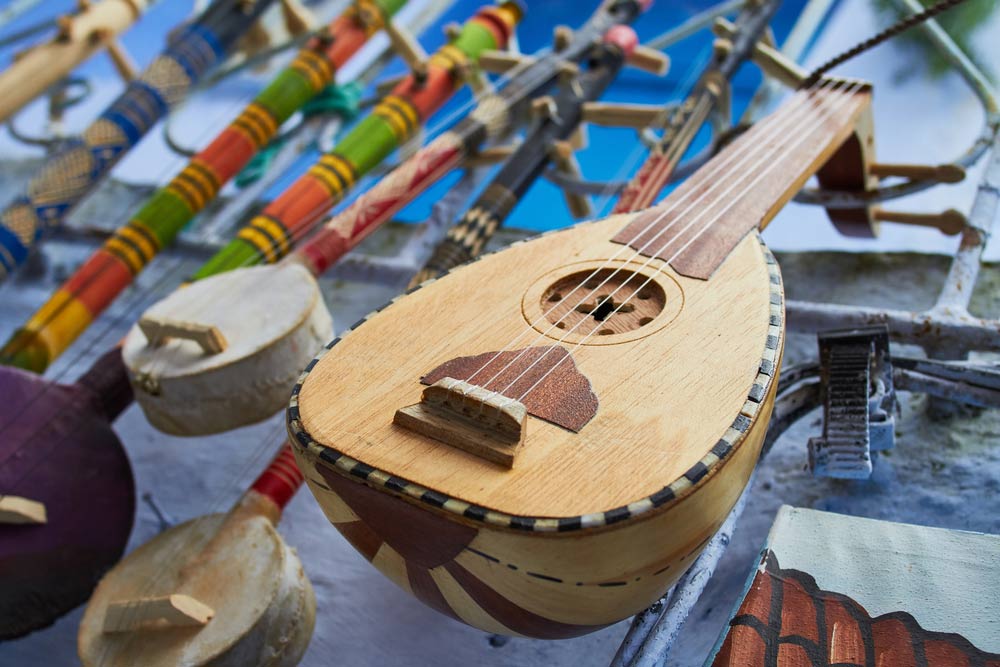
Gnawa
Gnawa music is a spiritual and trance-inducing genre that has its roots in the traditions of African slaves brought to Morocco. This music is integral to the rituals of the Gnawa brotherhood, which combines elements of Sufi Islam with African religious traditions. The primary instrument in Gnawa music is the “guembri,” a three-stringed lute, accompanied by metal castanets called “qraqeb.” Gnawa ceremonies, known as “Lilas,” involve music, dance, and prayer, and are intended to invoke spiritual healing and connect with ancestral spirits. The repetitive, rhythmic nature of Gnawa music creates a hypnotic effect that is central to these rituals.
Raï
Raï music, originally from Algeria, has become popular in Morocco. It emerged in the 1920s and combines traditional Bedouin music with modern genres like pop, jazz, and rock. Raï musicians use a variety of instruments, including the accordion, guitar, and electronic synthesizers. The lyrics often address contemporary social issues, personal struggles, and themes of love and freedom. Raï concerts and festivals attract large audiences, and the music has a strong following among Moroccan youth.
Malhun
Malhun is a form of sung poetry that originated in the urban centers of Morocco. This genre blends Arabic poetry with traditional Moroccan music. Malhun songs are composed of long, poetic narratives called “qasidas,” which can tell stories of love, historical events, or moral lessons. The music typically features instruments such as the oud, violin, and percussion. Performances of Malhun are often seen at cultural events and celebrations, preserving this important literary and musical tradition.
Moroccan music is rich in its variety of traditional instruments. The oud is a key instrument, known for its deep, resonant sound. The darbuka is a goblet-shaped drum that provides the rhythmic backbone for many musical styles. The qraqeb, metal castanets, add a distinctive metallic clatter to Gnawa music. Other instruments include the “ney” (a type of flute), the “rebab” (a stringed instrument), and the “qanun” (a zither-like instrument). Each instrument contributes to the unique soundscapes of Moroccan music, reflecting the country’s diverse cultural influences.
Modern Music Influences
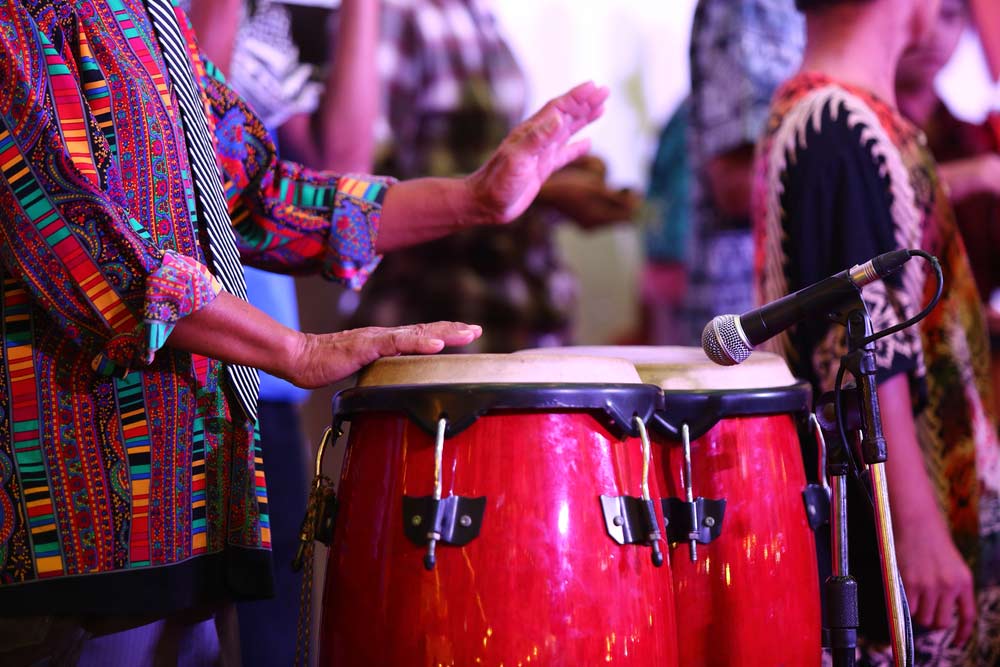
Funk, Rock, Hip-hop
Modern Moroccan music is an exciting blend of traditional sounds and contemporary genres like funk, rock, and hip-hop. Young Moroccan artists are innovatively fusing these styles, creating a vibrant music scene. Bands like Hoba Hoba Spirit mix rock with traditional rhythms, while hip-hop artists like Dizzy DROS incorporate Moroccan dialect and themes into their lyrics. This fusion not only keeps traditional music relevant but also allows for the expression of modern social and political issues. Concerts and music festivals in cities like Casablanca and Marrakesh showcase these modern sounds, drawing large, enthusiastic crowds.
El Hait (Hayt)
El Hait, also known as Hayt, is a contemporary Moroccan music genre that blends traditional Moroccan elements with modern beats. This style is particularly popular among the youth and often features electronic music influences. El Hait songs are catchy and often talk about everyday life, dreams, and social issues. The music is played at parties, clubs, and on the radio, reflecting the dynamic and evolving nature of Moroccan culture.
Traditional Dance Forms
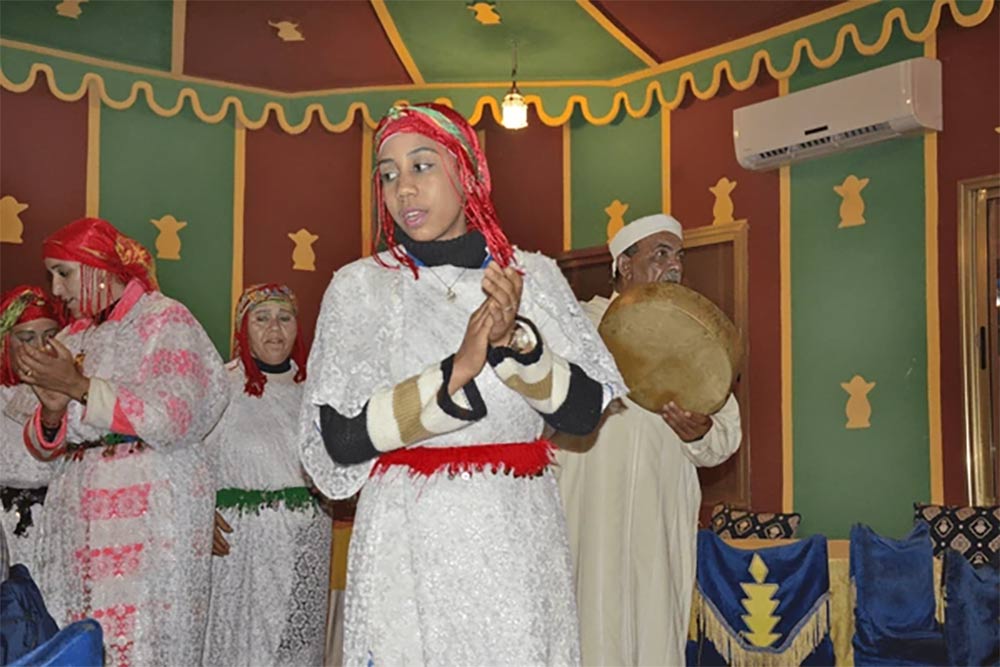
Shikhat
Shikhat is a traditional Moroccan dance performed by women at celebrations such as weddings and parties. The dancers wear colorful, flowing dresses and scarves, and their movements are energetic and expressive. Shikhat dance often involves rapid hip movements and intricate footwork, performed to the lively rhythms of Moroccan folk music. This dance is a joyful expression of celebration and is deeply ingrained in Moroccan cultural traditions.
Ahidous
Ahidous is a Berber dance from the Atlas Mountains, performed by both men and women. Dancers form a circle or line, holding hands and moving in unison to the beat of drums and flutes. The dance is a celebration of community and unity, often performed at festivals and communal gatherings. The synchronized movements and rhythmic clapping create a mesmerizing and harmonious display.
Chaabi
Chaabi, meaning “popular,” is a dance commonly seen at Moroccan parties and gatherings. The music is upbeat and fast-paced, encouraging spontaneous and joyful dancing. Groups of people dance together, clapping and singing along to the catchy tunes. Chaabi dance is lively and fun, reflecting the festive spirit of Moroccan social events.
Guedra
Guedra is a spiritual dance from the Saharan region of Morocco. It is performed by women who kneel on the ground and move their hands and upper bodies to the rhythm of drums. The dance is accompanied by chanting and drumming, creating a meditative and trance-like atmosphere. Guedra is often performed during ceremonies and rituals, serving as a form of prayer and spiritual connection.
Taskiwin
Taskiwin is a traditional warrior dance from the High Atlas Mountains. It involves men dancing with sticks, and performing synchronized movements that symbolize strength and bravery. The dance is accompanied by rhythmic drumming and chanting, creating an energetic and powerful performance. Taskiwin is performed at festivals and cultural events, showcasing the valor and heritage of the local communities.
Reggada
Reggada is a vibrant dance from the eastern Rif Mountains. It features quick foot movements, shoulder shakes, and the waving of handkerchiefs. Men and women dance together, often forming lines or circles. The music is lively and rhythmic, encouraging energetic and spirited dancing. Reggada is a popular dance at weddings and celebrations, bringing joy and excitement to the event.
Sufi Dance (Hadra)
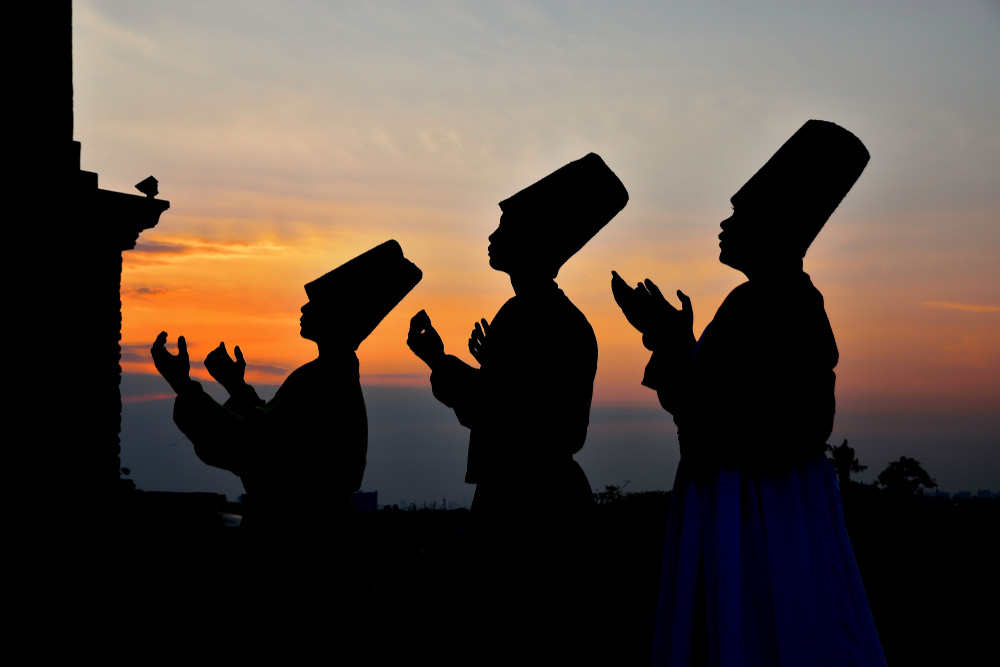
Sufi Dance, also known as Hadra, is a spiritual dance performed by Sufi Muslims during religious ceremonies. Dancers move in circles, swaying and chanting to the rhythm of drums and flutes. The dance is a form of worship and devotion, aiming to reach a state of spiritual ecstasy. Sufi Dance is often performed during religious festivals and gatherings, reflecting the deep spiritual traditions of Moroccan Sufism.
Houara
Houara is a traditional dance from southern Morocco. It is performed by both men and women, who dance in a line, moving their feet and hips to the rhythm of drums and flutes. The dance is joyful and energetic, often performed at festivals and celebrations. Houara showcases the lively and expressive nature of Moroccan dance traditions.
Dakka Marrakchia
Dakka Marrakchia is a rhythmic dance from the city of Marrakesh. It involves clapping, drumming, and chanting, creating a festive and lively atmosphere. Groups of people dance together, following the beat of large drums and the melodic chants. Dakka Marrakchia is performed at weddings, celebrations, and cultural events, bringing people together in joyful unity.
Modern Dance Adaptations
Contemporary Dance Influences
Modern Moroccan dance is a blend of traditional and contemporary styles. Dancers incorporate traditional movements with modern techniques, creating innovative and dynamic performances. Contemporary dance in Morocco is performed in theaters, festivals, and on television, reflecting the evolving nature of Moroccan culture. This fusion keeps traditional dance forms alive while allowing for creative expression and adaptation to modern influences.
Renowned Musicians
Nass El Ghiwane
Nass El Ghiwane is a legendary Moroccan music group that emerged in the 1970s. Known as the “Rolling Stones of Morocco,” they mix traditional Moroccan music with modern sounds. Their songs address social and political issues, capturing the spirit of their times. The band uses traditional instruments like the guembri and the darbuka, along with modern guitars and drums. Nass El Ghiwane’s music is powerful and thought-provoking, and they have inspired many artists both in Morocco and internationally.
Master Musicians of Jajouka
The Master Musicians of Jajouka are renowned for their ancient musical traditions. Hailing from the Rif Mountains, their music is spiritual and trance-inducing. They play a variety of traditional instruments, including the “ghaita” (a type of reed flute) and drums. Their music is used in rituals and healing ceremonies, aiming to connect with ancestral spirits. The Master Musicians of Jajouka have gained international fame and have collaborated with many famous artists, bringing their unique sounds to a global audience.
Prominent Dancers
Karima Skalli
Karima Skalli is a celebrated Moroccan dancer known for her graceful movements and expressive performances. She blends traditional Moroccan dance with modern techniques, creating captivating performances. Karima has performed at many international festivals, showcasing the beauty and richness of Moroccan dance. Her talent and creativity have made her a prominent figure in the world of dance.
Hassan Hakmoun
Hassan Hakmoun is a talented dancer and musician specializing in Gnawa music and dance. His performances are energetic and captivating, showcasing the spiritual and rhythmic nature of Gnawa traditions. Hassan has toured around the world, sharing his cultural heritage with global audiences. His dedication to preserving and promoting Gnawa music and dance has made him a respected and influential artist.
Conclusion
Moroccan music and dance offer a fascinating glimpse into the country’s rich cultural heritage. Each musical genre and dance form, from the soulful Gnawa rhythms to the lively Shikhat dances, tells a unique story of Morocco’s diverse history and vibrant communities. Traditional instruments like the oud, darbuka, and qraqeb contribute to the distinct sounds that define Moroccan music, while dance styles such as Ahidous and Dakka Marrakchia highlight the communal and celebratory aspects of Moroccan life.
In recent years, the fusion of traditional and modern styles has breathed new life into Moroccan music and dance. Artists and performers creatively blend genres like funk, rock, and hip-hop with age-old melodies and movements, showcasing Morocco’s ability to adapt and innovate while honoring its roots. This blend not only keeps the cultural practices alive but also resonates with younger generations, ensuring the continuation of these rich traditions.
By exploring the music and dance of Morocco, we gain a deeper appreciation for the country’s cultural richness and diversity. These art forms are not just entertainment; they are vital expressions of Moroccan identity and heritage. Whether through the mesmerizing rhythms of Gnawa music or the energetic movements of Chaabi dance, Moroccan music and dance invite us to celebrate, connect, and experience the soul of this vibrant nation.
